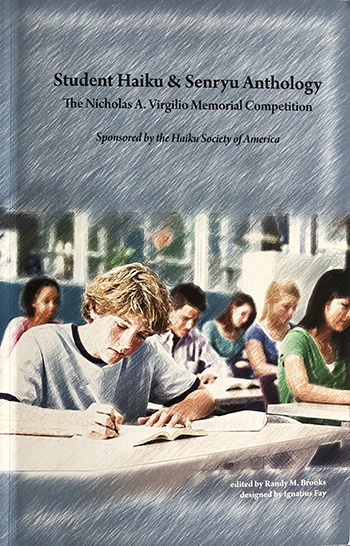Haiku Society of America Student Haiku Awards
in Memorial of Nicholas A. Virgilio
~ ~ ~
Student Haiku Awards for 2006
Michael Ketchek and Jerome Cushman
judges
Judging this contest was a pleasure. There were nearly thirty more excellent poems that fit the definitions of haiku or senryu and could have placed in the top six. There were many excellent poets, who we hope will continue to create. We encourage them to send their best poems to the many haiku journals and magazines in print and on the Internet. Many of the poems we read should be seen by the haiku world.
However, there were another fifty poems that lacked the form and feeling of haiku or senryu. We wish that the teachers who encouraged these students to enter this contest were more aware of the structure and style of contemporary haiku. This can be learned by reading haiku in the well-known periodicals and many sites on the Web. Teachers and students can also encourage their libraries to purchase some of the fine haiku books that are available, such as The Haiku Handbook, by William J. Higginson and Penny Harter, Haiku: A Poet’s Guide, by Lee Gurga, or Writing and Enjoying Haiku, by Jane Reichhold. These will help everyone achieve a better grasp of the elements of successful haiku and senryu. ~ Michael Ketchek and Jerome Cushman
Iraqi sun
an American soldier
pisses in the sandElishma Farquharson
School of the Arts, Age 18, grade 12, Rochester, NYForget about politics and think about the image of urine hitting hot sand, being soaked up by the earth, and soon disappearing. This image aloe can bring about many thoughts concerning the relationship between man and nature. Certainly, the insignificance of one man in comparison to the vast desert is highlighted by how little effect one man’s water has on all that dryness. A man in the desert is a lonely image. Add to that the loneliness of a soldier in a foreign land to get a feeling for all that is implied by this haiku. Now and only now add the political implications and this haiku has even more layers of meaning. It nicely demonstrates how to blend contemporary and eternal issues into a successful poem.
three stones on a fence
Cory Steinmetz
Vermilion High School, Age 17, Grade 11, Vermilion, OHDon’t let the simplicity of this short one line haiku fool you. In it is the mystery of human creativity. The poet has created a scene in which we are told very little, but are given a huge amount to contemplate. There are three stones on a fence that had to have been placed there on purpose. One or two stones could be perceived as mindless human action but three is enough to indicate a plan. Thankfully we are not given a clue as to the nature of this plan. These three stones remain a small mysterious Stonehenge. And as in Stonehenge, contemplating the mystery is endlessly engaging.
new year’s day
walking in yesterday’s
frozen footprintsIsabelle Bartter
School of the Arts, Age 17, Grade 11, Rochester, NYThis haiku, with its clean, clear imagery, speaks of the relationship of the present and the future to the past. For all the talk of new beginnings on New Year’s Day, the past remains unchanging and influential. In a poetic and personal way this haiku says something very similar to what Karl Marx wrote, “Men make their own history, but they do not make it just as they please; they do not make it under circumstances chosen by themselves, but under circumstances directly encountered, given, and transmitted from the past.” They make it, “walking in yesterday’s frozen footprints.”
fireworks
a boy nestles
into his motherFantazia Edic
School of the Arts, Age 18, Grade 12, Rochester, NYVivid images universal and at the same time very personal, come to mind with this plan and poignant haiku. The vastness of the whole sky filled with bright colors and loud sounds is quickly refocused to a child seeking the security and warmth of his mother. Time, place, and characters we care about, all in an emotional event, are clearly drawn here.
Seven words and eleven syllables paint a mural for both the young and us old guys. The interesting use of the sibilant “s” in each line also helps us recall the sound of those rockets shooting into the sky. Even after reading this poem many times we come back to it for yet more images.
the coarse wool
of my blanket
a cricket’s raspGiulia Perucchio
School of the Arts, Age 15, Grade 10, Rochester, NYHere is a clever use of synesthesia, drawing the tactile and auditory senses into one experience. The feeling of that “coarse wool” and the sound of the cricket outside blend into a unique, melancholy moment. The use of “rasp” for the cricket’s sound in late autumn is appropriate for the intended metaphor.
This verbless haiku presents us with a sensation-packed event that can be shared by many readers. Here, too, the sounds of the words reinforce the images. The poet uses just eleven syllables and nine words to produce a powerful poem.
bean stalks
none of my clothes
fitGen Poehner
School of the Arts, Age 16, Grade 11, Rochester, NYThis is a special poem by and for the adolescent. That image of the “bean stalks” brings to mind the concept of something fast growing and also the children’s tale Jack and the Beanstalk. The second line jars the mind, taking it in a very different direction. Here is another poem that uses clever juxtaposition of images that present us with two independent ideas synthesized into a wonderful story.
The growth spurts that make a youth feel out of clothes, out of sorts, and out of place are common to many teenagers. The way “fit” sits there all alone on the third line reflects the awkwardness and loneliness that a fast growing young person often experiences.
~ ~ ~
